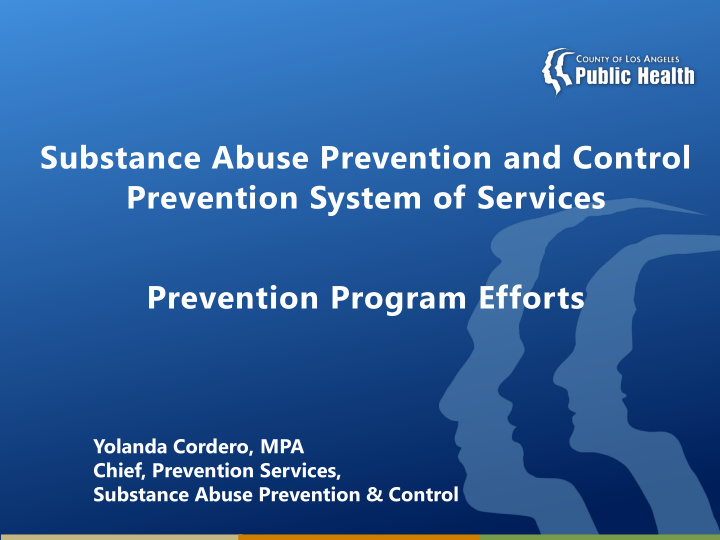



Substance Abuse Prevention and Control Prevention System of Services Prevention Program Efforts Yolanda Cordero, MPA Chief, Prevention Services, Substance Abuse Prevention & Control
1 Prevention Program Efforts ➢ Rethinking Access to Marijuana Coalition ➢ Marijuana Campaign ➢ DPH-SAPC Cannabis Summit ➢ Emerging Leaders Youth Summit ➢ Marijuana Education Initiative (MEI) Pilot ➢ Community Needs Assessment (CNA) Surveys ➢ Cannabis Education, Prevention and Intervention (EPI) Workgroup ➢ Marijuana Public Smoking Initiative (MPSI) ➢ Community Health Environmental Scan (CHES)
CNA Findings: Access and Availability • 62% of survey responders felt that it was easy for them to get marijuana on the streets around their neighborhoods • Slightly over half of youth, ages 12-17, felt they had easy access to marijuana • Over 70% of young adults between 18-20 reported having easy access to marijuana
CNA Findings, Prevalence 48% of all • responders reported having used marijuana at least once in their lifetime. Among those who • reported lifetime use of marijuana, 29% reported current use of marijuana. • Among youth, 26% and among young adults 53% reported using marijuana at least once in their lifetime.
CNA Findings: Perception of Harm 40% of all survey • responders felt there was some harm associated with marijuana occasional use! Among Youth, • 12-17, about 30% believed occasional cannabis use was harmful. Perception of harm • was much higher among the foreign born respondents!
CNA Findings: Perception of Harm 59% of survey responders • felt there was no harm associated with marijuana use; 16% believed there was harm • if driving under the influence. 13% of responders felt • cannabis use would decrease motivation! 12% were concerned about • illegal activities! 11% felt it would lead to poor work performance.
CNA Findings: Cannabis Use Consequences 27% of all survey reported having gone to work or school under the influence of marijuana! Almost half (49%) of Youth, ages 12-17, and 31% of young adults ages 18-20 reported having gone to school under the influence!
7 Marijuana and the Teen Brain What We Now Know ➢ Adolescence is a critical period in brain development. ➢ The brain is still developing until approximately age 25
ADOLESCENT BRAIN DEVELOPMENT The Prefrontal Cortex is responsible for controlling planning, working memory, organization, modulating mood, and is constantly changing and growing. The Limbic System is responsible for controlling emotion and other brain functions related to our instincts and memories, such as giving a sense of reward for engaging in risk.
ADOLESCENT BRAIN DEVELOPMENT ➢ Underdevelopment of the frontal lobe/prefrontal cortex make adolescents more prone to “ behave emotionally or with ‘gut’ reactions ” ➢ Adolescents tend to use an alternative part of the brain – the AMYGDALA (emotions) rather than the prefrontal cortex (reasoning) to process information.
Cannabis and the Adolescent Brain The National Institute on Drug Abuse Blog Team. (2014, December 1). Marijuana Use Can Lower Your Grades. Retrieved from https://teens.drugabuse.gov/blog/post/marijuana-use-can-lower-your-grades on March 19, 2018. 10
11
12
TEENS AND EDIBLES Recent research indicates that Marijuana-infused food product (i.e., edible) use is becoming nearly as common as smoking marijuana where medical marijuana is available. Teen Use of Marijuana Edibles: A Focus Group Study of an Emerging Issue J Prim Prev. 2016 Jun; 37(3): 303 – 309. doi: 10.1007/s10935-016-0432-9
Infused Products Use of either plant, hash oil or concentrates in edibles and drinks Eaten as ingredient in baked goods, candies, and sodas THC concentration varies per item with no current regulation on dosage Amounts of THC in edible products can vary widely.
15
Resources • LAC Substance Use Treatment Services Screening and Referral Call 1-844-804-7500 • • DPH – Substance Abuse Prevention and Control, Prevention Services: Prevention Website http://publichealth.lacounty.gov/sapc/prevention/PreventionLinks.ht m • DPH Prop 64 Resource Webpage: http://publichealth.lacounty.gov/sapc/Prop64/Proposition64.htm • LA County Office of Cannabis Management: https://www.lacounty.gov/marijuana 16
Recommend
More recommend